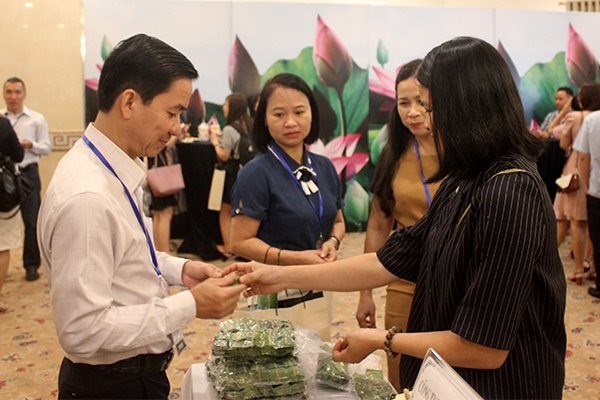 |
|
Representatives of various firms exchange products to be exported to the EU market on the sidelines of the forum on December 19 (Photo: saigontimes.vn)
|
Pham Binh An, Director of theHCM City International Integration Support Centre, said the EVFTA was expected to increase Vietnam’s GDP by 4.3 percent by 2030, and exportsto the EU could surge by about 44 percent by 2030.
Speaking at a forum oninternational economic integration in Ho Chi Minh City on December 19, Annoted, however, that trade remedies such as anti-dumping, anti-subsidy andsafeguard measures could arise on Vietnamese exports.
Exporters shouldrestructure their production and export output to avoid anti-dumpingand anti-subsidy investigations, and “should follow product origin rulesand trade fraud to avoid lawsuits”, he said.
According to recent data fromthe Provincial Competitiveness Index Report, only 1.55 percent of Vietnameseenterprises surveyed had in-depth knowledge of the EVFTA. More than65 percent of the surveyed enterprises had only heard of it briefly.
Vu Xuan Phong, former vicepresident of Vietnam International Arbitration Centre (VIAC), said the signingof EVFTA had opened a new era for both Vietnam and the EU as thecountry would have access toEurope’s 500 million-strong consumer market.
Vietnam is among the top 10exporting countries to the EU. Within ASEAN, Vietnam is EU’s secondbiggest trade partner and largest exporter of goods.
“However, most Vietnameseenterprises still do not have a deep understanding of the major free tradeagreement,” he said. “This is a worrying sign.”
Nguyen Thao Hien, Deputy Directorof the European-American Market Department under the Ministry of Industry andTrade, said the EU was Vietnam’s second largest export partner in2018, after the US. However, in the first 11 months of 2019 exportsreached only 38.38 billion USD, a slight drop of 1.26 percent over the sameperiod last year.
The signing of EVFTA wouldprovide great opportunities for Vietnamese agricultural products, footwear,textiles, computers, plastic products, and seafood.
Other key sectors includeautomobiles and motorcycles, green growth, intellectual property rights,transportation and logistics.
The elimination of bilateraltariffs and export taxes as well as the reduction of non-tariff barriersaffecting cross-border exchanges of goods and services is expected toboost bilateral trade, she said.
However, the EU has set strictcriteria for product quality to protect consumers’ health, including hightechnical standards and regulations on packaging and labeling,she added.
“Vietnamese enterprises must befully aware of the commitments made by Vietnam in the tradeagreement.”
Hien said that enterprisesmust adhere to Rules of Origin (RO), especially as traceabilityregulations for importing countries have become increasingly strict.
Enterprises should alsomeet food safety and hygiene standards and management procedures setby the EU, as well as corporate social responsibility and transparency ofinformation on labour and the working environment, she said.
The use of modern methodswill ensure strict control of goods’ authenticity, quality andorigin, she added.
To enhancecompetitiveness, Vietnamese manufacturers should also shiftto advanced production and processing systems, according to Hien.
From a legal perspective, ChauViet Bac, deputy secretary general of VI-AC, said that commercial arbitrationcould resolve conflicts between the Government and investors or betweenenterprises and enterprises in trade deals.
Thanks to a simple andfast process, commercial arbitration has become effectivefor businesses that encounter problems in signing contracts,while helping facilitate access to the EU market.
Truong Dinh Hoe, General Secretaryof the Vietnam Association of Seafood Exporters and Producers (VASEP), saidthat enterprises of seafood exports had prepared all the requiredconditions of the EU to obtain certificate of origin, certificate of foodhygiene and safety, and certified environmentally friendly products.
VASEP in 2019 failedto achieve its target of 2 billion USD worth of exports of seafood to theEU. The association has set the same target for 2020, accounting for20 percent of the country’s total seafood export, according to Hoe.
The EVFTA, signed on June30 in Hanoi, is one of the most ambitious agreements concluded between the EUand Vietnam. Over a 10-year period, more than 99 percent of tariffs ongoods from both sides will eventually be removed./.VNA
 Vietnamese businesses should prepare to deal with potential trade barriers that could arise early next year when the European Union-Vietnam Free Trade Agreement (EVFTA) takes effect, experts have said.
Vietnamese businesses should prepare to deal with potential trade barriers that could arise early next year when the European Union-Vietnam Free Trade Agreement (EVFTA) takes effect, experts have said.